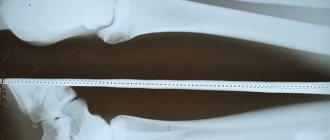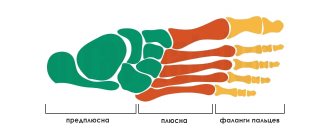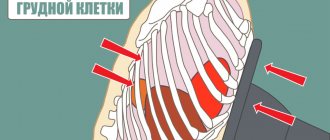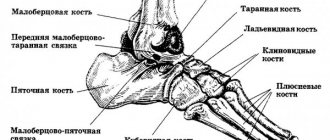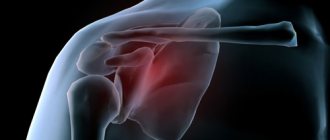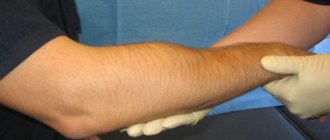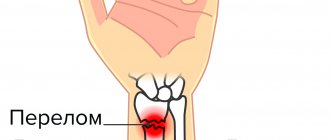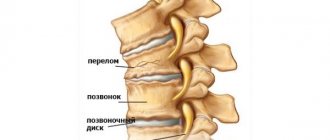The SANMEDEXPERT clinic treats all types of injuries to the musculoskeletal system, including closed fractures.
A closed fracture is a bone injury that breaks its integrity without damaging the skin over the injury site. Closed fractures are much more common than open ones. Often they are not detected immediately, hiding behind soft tissue swelling, especially if the injury is not accompanied by displacement of bone fragments. A closed fracture of the ribs with displacement is very dangerous - the sharp ends of their fragments cause damage to the chest organs (primarily the lungs and large vessels) even leading to death.
Causes of closed fracture
A closed fracture in the vast majority of cases is the result of a mechanical force that exceeds the strength of the bone. Such injuries are not uncommon in road traffic accidents. At the same time, each individual person has their own threshold of strength. It depends on a large number of different factors: the type of bone, the health of the bone tissue, the vector and area of application of the traumatic force, the person’s age and others. The leaders in fractures are the radius of the upper extremities and the fibula of the lower extremities. But this is at a young age. In the elderly, hip fractures come first. This is due to the condition of bone tissue caused by a deficiency of sex hormones and the development of osteoporosis. The rate of healing of a closed fracture will largely depend on its nature, the size of the injured bone, the age of the patient, the chosen treatment tactics and concomitant diseases.
Types of fractures
Fracture
- partial or complete violation of the integrity of the bone. Most often, fractures occur when a bone is suddenly exposed to significant mechanical force when the skeletal system is not changed. Such fractures are called mechanical (traumatic). The integrity and continuity of the bone can also be disrupted by the pathological process developing in it. Such a fracture is called pathological (spontaneous). It can occur without any external influence or it can be very minor.
Violation of bone integrity under the influence of mechanical force is always accompanied by damage to soft tissues. The degree of damage to the latter, as well as the nature of the fracture, largely depends on the strength of the mechanical impact. A violation of the integrity of a bone, when the connection between its parts is not broken, is usually called a crack (fissura).
In clinical practice, fractures are quite common. So, according to the Institute of Emergency Medicine named after. Sklifosovsky in Moscow, fractures of various bones were detected in 33.2% of cases, i.e., almost every third patient admitted with injury had a bone fracture. In this case, fractures were most often localized in the bones of the extremities (61.2%). According to statistical data from outpatient departments, a significant place among bone fractures is occupied by fractures of the bones of the foot and hand (62.5%).
Most cases of fractures occur between the ages of 20 and 40 in men. The incidence of certain types of fractures is closely related to certain seasons. Thus, spinal fractures are more common in the summer during the swimming season, and ankle fractures and epiphyseal bone fractures are more common in winter due to falls on icy roads. Fractures of the lower extremities.
Classification of fractures:
Depending on whether the bone wound communicates with the external environment through damaged body tissue or not, all fractures should be divided into closed and open. This division of fractures is fundamentally very important, because with open fractures, there is always a danger of pathogenic microorganisms entering the wound and developing a purulent or putrefactive inflammatory process in the fracture zone. This must always be taken into account when providing first aid to a victim with a fracture, and even more so when treating fractures.
According to location, fractures are divided into diaphyseal, metaphyseal and epiphyseal
.
Epiphyseal (intra-articular)
fractures are the most severe.
With them, the configuration of the joint is sharply disrupted and very often a persistent disturbance of movements in it remains. In some cases (especially in children), there is a separation of the epiphysis, the so-called epiphysiolysis, which is most often observed in the area of the epiphysis of the humerus, radius and tibia.
Metaphyseal (periarticular fractures)
They are often fixed due to the adhesion of one bone fragment to another. Otherwise, they are called driven in. The periosteum is often not damaged in these fractures. Therefore, such fractures often have the character of cracks in the form of longitudinal, radiant and spiral lines.
In clinical practice, diaphyseal fractures are more often encountered .
Taking into account the mechanism of fracture formation, it is customary to distinguish fractures from axial compression, from flexion, from torsion. The mechanism of various types of bone fractures is based on the laws of mechanics, according to which molecules, under the influence of injury, either approach each other (compression, compression fractures) or move away from each other (avulsion fractures). Or, finally, they move in relation to each other as if along a screw thread (spiral, helical fractures). The degree of bone destruction depends on the duration of exposure of the bone to an external traumatic factor and the direction of the force of this factor.
Fractures from compression or compression can occur both longitudinally and transversely to the axis of the bone. Long tubular bones are more often damaged when they are compressed in the transverse direction than in the longitudinal direction. Compression of these bones in the longitudinal direction leads to the formation of impacted fractures. Often compression fractures are localized in the spine, the vertebral bodies of which seem to be flattened.
Flexion fractures occur from direct and indirect violence. The bone bends to the limit of its elasticity and breaks. In this case, on the convex side of the bone, a rupture of its surface parts occurs, and a series of cracks running in different directions is formed. The bone breaks, sometimes forming a triangular fragment.
Fractures caused by twisting along the longitudinal axis of the bone are called torsion, spiral or helical. These fractures are localized in large tubular bones (femur, shoulder, tibia). The fracture is usually located away from the point of application of force.
Avulsion fractures occur due to a sharp muscle contraction that occurs suddenly. In this case, sections of the bone are torn off, to which the sharply contracted muscle is attached.
Depending on the degree of violation of the integrity of the bone, fractures are usually divided into complete and incomplete (cracks). In a complete fracture, the bone is damaged along its entire tissue length, which allows the bone fragments to move relative to each other (displaced fractures). With incomplete fractures, displacement of bone fragments does not occur (fractures without displacement). A typical example of an incomplete fracture is a subperiosteal fracture, which occurs in children under 15 years of age.
According to the direction of the bone fracture line, it is customary to speak of transverse fractures.
(the fracture line is perpendicular to the axis of the bone),
longitudinal
(the fracture line runs along the axis of the bone).
Oblique
(the fracture line is directed towards the axis of the bone at an angle),
helical or spiral
(twisting of bone fragments along its axis). The reasons that lead to the displacement of bone fragments during a bone fracture can be divided into three types: 1) primary displacement, which occurs due to the action of physical force and the direction of its action; 2) secondary displacement caused by contraction of the muscles attached to the broken bone; 3) tertiary displacement, formed when secondary external mechanisms act on the damaged bone (improper transportation from the site of injury, restless behavior of the patient). When bone fragments are displaced, muscles, tendons, and nerves can become wedged between them, which significantly complicates the course of the fracture and affects its treatment (interpositional fractures). Depending on the number of damaged areas of the bone, it is customary to distinguish between single and multiple bone fractures.
Multiple fractures are also spoken of in cases where the victim has several broken bones.
If a bone fracture causes damage to organs located in the area where the fracture is located, then such fractures are called complicated. If a fracture is not accompanied by damage to organs, then it is called simple, however, it should be noted that in reality there are no simple fractures, since with a fracture there is always damage to the soft tissue in the area of its location. But since these tissue injuries do not require special treatment, these fractures are considered uncomplicated.
Complicated include fractures of the skull with damage to brain tissue, fractures of the pelvis with damage to the pelvic organs, open fractures, and fractures of bones with damage to large vessels and nerves.
Go to the Rehabilitation section
Signs of a closed fracture. How not to confuse it with a bruise?
distinguish a closed fracture from an open one. It is much more difficult to draw the line between a violation of the integrity of the bone and a severe bruise. The symptoms of both injuries are very similar, but there are also differences. Let's name them.
- Pain intensity. When a bruise occurs, the pain is moderate, it quickly subsides and completely disappears within a few days. With a fracture, the pain is much stronger, its intensity decreases slightly over time, and interferes with the usual actions.
- Edema. In case of a bruise, swelling occurs only at the site of injury; in case of a fracture, it spreads to the entire limb.
- Hematomas. In case of a bruise, bruises, as a rule, are small and form at the site of impact. With a fracture, the hemorrhages are more extensive and spread over a larger area.
- Movements. When bruised, a person can perform usual actions - lean on a leg or use an arm. With a fracture this is impossible.
A closed fracture also has specific signs that are uncharacteristic of a bruise: the sound of a breaking bone at the time of injury, shortening of the damaged limb, its ability to bend at an unusual angle and abnormal mobility.
Signs of a fracture
A fracture can be diagnosed based on a number of signs:
- sharp, severe pain in the corresponding area;
- swelling of the tissue;
- swelling;
- clearly visible deformation of the damaged area;
- limited body movements or inability to do so;
- forced adoption of a certain posture to overcome severe pain;
- shortening of limbs;
- pain when tapping;
- sounds of bone fragments crunching under the surface of the skin.
The body's reaction to a closed fracture
Doctors conditionally divide them into local, that is, manifesting themselves at the site of the fracture, and general, occurring throughout the body.
Local reactions are severe pain, making it impossible to physically load the injured limb; reflex muscle contraction that provides some stability to the broken bone; hematoma caused by the accumulation of blood from damaged vessels in the space between the soft tissues; edema.
General reactions of the body include increased body temperature, shortness of breath, interruptions in heart function, cough, and decreased urine volume. This is often observed, for example, when adipose tissue enters the vascular bed and spreads through the bloodstream. General reactions of the body can worsen the condition of the injured person and even cause death. Therefore, if they occur, it is necessary to immediately call an ambulance. Simple fractures, as a rule, are not accompanied by such reactions.
Consequences of closed and open fractures
A closed injury in a short period of time (one or two days) can develop into an open wound due to the development of necrosis (death) of the skin and excessive pressure, in which the fragment breaks through the weak skin. This phenomenon is called a secondary open fracture.
Other consequences:
- Sometimes small bone fragments remain in the skin and become a kind of splinter that can develop into a subcutaneous lump with painful sensations.
- A poorly treated open trauma wound is susceptible to infection and can host harmful bacteria, which in the future will cause the wound to fester.
- The most common negative consequence of a fracture is malunion of the bone , which also includes pseudarthrosis. Post-traumatic swelling may also be a concern, interfering with the normal functioning of the restored part of the body.
- During treatment, it is necessary to constantly and timely take x-rays of both the injury site and the adjacent bones and joints in order to avoid bone fragments, malunion and calluses.
Particular attention is paid to children's fractures, since a growing body faster than an adult will give rise to fusion, which may be incorrect.
No matter how serious the damage to a limb is, it is worth excluding self-medication in the absence of the ability to provide first aid and immediately call an ambulance.
Classifications of closed fractures
Various classifications of closed fractures help the doctor choose treatment tactics and make a prognosis for recovery and rehabilitation.
- I. Due to the occurrence:
- traumatic – caused by the influence of some force;
- pathological - arise due to deterioration of bone tissue due to some disease, for example, tuberculosis.
- II. By severity of injury:
- complete – the bone breaks into several parts (two or more);
- incomplete - a crack forms in the bone.
III. By displacement of fragments:
- with displacement - bone fragments move sideways relative to each other;
- without displacement - bone fragments are held in their normal position by muscles, ligaments and tendons.
- IV. According to the shape and direction of the fracture:
- longitudinal – the fracture is located along the bone;
- transverse - a fracture across the bone;
- oblique - a fault along a diagonal;
- comminuted - a fracture with the formation of several fragments;
- wedge-shaped - a wedge-shaped fragment has formed;
- helical - a break in a spiral, reminiscent of a screw;
- impacted - one bone fragment enters another;
- compression – the bone is compressed, its length is reduced, and there is no fracture line.
- V. According to the presence of complications:
- uncomplicated - only local symptoms of a fracture are observed, the general condition of the patient is not impaired;
- complicated - the appearance of local signs is accompanied by traumatic shock, damage to soft tissues and organs, infection and other complications.
First aid for a closed fracture
A person’s further recovery after injury, his health and even his life depend on how competently it is provided.
First, you need to make sure that there is a closed fracture and not a bruise, and call an ambulance. If the bone is really broken, you should take care to prevent the development of pain shock and the appearance of swelling. For this purpose, ice should be applied to the site of injury, periodically replacing it with a new one. It is a good idea to give the victim painkillers in tablets or injections. It is strictly forbidden to use alcohol as an analgesic. Strong drinks contribute to the destruction of bone cells and slow down the healing of bone fragments.
The next step is to fix the damaged body part or limb with a splint in the position in which it finds itself. If bone fragments are not immobilized, they can injure blood vessels and soft tissue and cause extensive bleeding. You can use any hard object as a tire: a board, a ski pole or a tree branch.
Before applying a splint, the limb is wrapped in soft material - tow, moss, pieces of clothing - to protect the injury site from the pressure of the bandage. Then the splint is tightly tied to the body using improvised means. This could be a belt, scarf, rope. If a vessel is damaged - this will be indicated by a rapidly increasing in size and pulsating hematoma - it is necessary to stop the internal bleeding. For this purpose, a tourniquet is applied just above the injury and the exact time of application is noted in order to then report it to the emergency doctors.
Recovery after a fracture
There are three stages of bringing the damaged part of the body into working condition:
- Immobilization. Most often this is the application of a plaster cast, the wearing of which can last from one month to six months or more. Along with immobilization of the limbs, bed rest is prescribed, which lasts from two days to two weeks. It is worth understanding that immobility contributes to the deterioration of muscle function and a decrease in muscle mass.
- Post-immobilization. Here the emphasis is on the regeneration of bone and muscle tissue and restoration of the ability to control the limb. This includes light physical exercise. loads, including physical and mechanical therapy. The main emphasis is on the ability to flex the joint. They do this from six months to a couple of years, depending on the results.
- Restorative. It is determined by the complete return of the bone to working condition. Exercises in water (swimming pool) and using exercise equipment help. The last stage can last almost a lifetime, since it is important to constantly maintain the tone of the damaged area and eliminate residual signs.
Treatment of a closed fracture
Restoring bone integrity after a closed fracture usually comes down to two principles:
- if the bone fragments are not displaced, they are held in the correct position until complete fusion with the help of a plaster cast, polymer bandages or special splints - splints, orthoses, braces (conservative treatment);
- when bone fragments are displaced, they are compared without a skin incision under local or general anesthesia and fixed with a plaster cast (closed reduction) or with a skin incision and fixation of the fragments with metal structures (open reduction).
It is also possible to compile bone fragments using the skeletal traction method. It consists in the fact that a specially mounted system pulls the bone in the desired direction, and gradually the fragments occupy the required correct position. After this, they are held using the same system in a given position until fusion.
Typically, a closed fracture heals much faster than an open one. However, in some cases this process may take longer. This happens, for example, when a patient suffers from osteoporosis, a disease of loose, weak bones. The formation of callus is delayed due to disruption of metabolic processes in bone tissue. Taking too long to recover can cause fatal complications. However, fortunately, it is possible to influence the rate of bone fusion.
Diagnosis of fractures
Only a traumatologist (sometimes a surgeon or neurologist) can accurately determine the complexity and type of injury based on its symptoms after the patient’s medical history and special checks, including x-rays.
You can independently identify approximately absolute and relative characteristics. Relative signs make it possible to predict pathology, while absolute ones become confirmation of destruction.
As for the professional study of the issue, doctors primarily use radiography, where two pictures are taken of the damage itself and neighboring joints.
Helps in studying signs also:
- computer (examination of bone structure) and magnetic resonance (study of soft tissues) tomography;
- Ultrasound of the joint;
- arthroscopy.
Comminuted fracture of the arm
How to speed up bone healing in a closed fracture?
Russian scientist, professor, prominent specialist in the field of treatment of diseases of the musculoskeletal system V. I. Strukov developed the drug Osteomed Forte , which allows accelerating the formation of callus by 1.5–2 weeks. In addition to calcium and vitamins D3 and B6, its composition includes a unique natural component HDBA organic complex, which allows you to equalize hormonal levels and normalize destructive and regenerative processes in bone tissue without harm to health.
Research conducted at the Institute for Advanced Medical Studies in Penza has shown that this development not only increases the mineral density of bone tissue without hormone replacement, but also closes the cavities formed in it, at the location of which fractures most often occur.
The drug gently and physiologically corrects the processes occurring in the bones; its use is absolutely safe.

